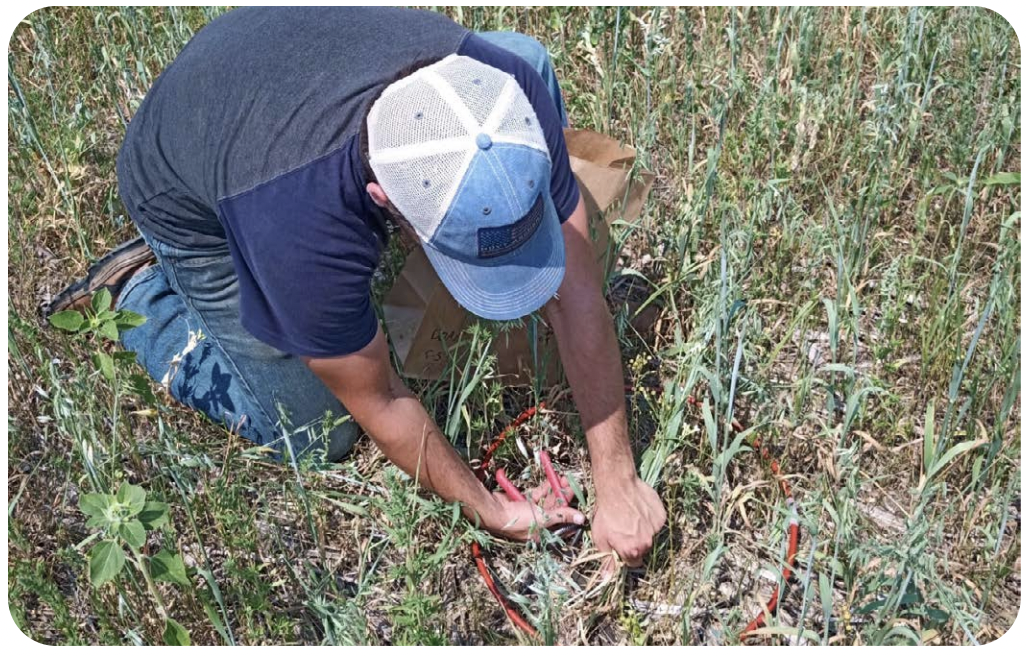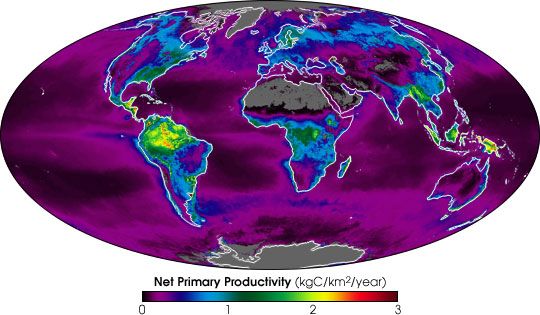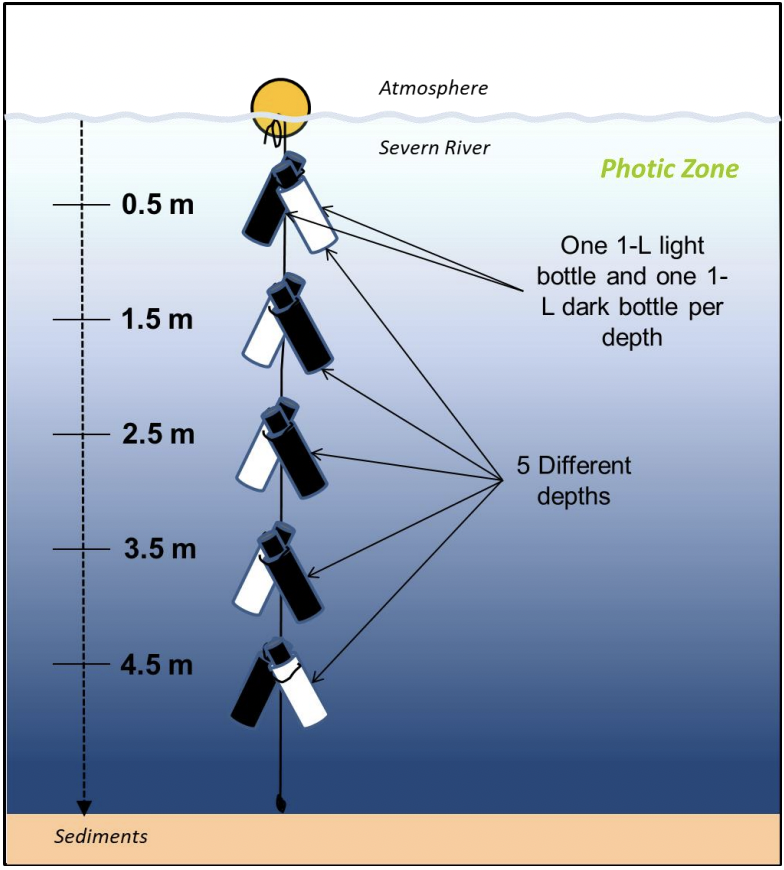IB Syllabus focus:
‘Biomass production from external energy and inorganic carbon/elements; typically kg C m⁻² yr⁻¹. Measure via lab photosynthesizing samples or field biomass change over time.’
Primary productivity is a cornerstone of ecology, representing the rate at which energy from the sun or other sources is converted into living biomass. Understanding its definition, measurement, and units is fundamental for evaluating the flow of energy through ecosystems and the limits of food webs.
Defining Primary Productivity
Primary productivity refers to the generation of organic compounds by autotrophs from inorganic sources using external energy.
Primary Productivity: The rate at which autotrophs convert inorganic carbon and other elements into biomass using external energy sources.
This process is central because it provides the energy base of ecosystems, fuelling consumers at higher trophic levels.
Gross vs Net Primary Productivity
There are two key forms of primary productivity:
Gross Primary Productivity (GPP): Total energy fixed by autotrophs during photosynthesis.
Net Primary Productivity (NPP): Biomass available after autotrophs subtract their own respiratory needs.
Gross Primary Productivity (GPP): The total rate of energy capture by autotrophs through photosynthesis.
Net Primary Productivity (NPP): The rate of biomass accumulation after accounting for autotrophic respiration (NPP = GPP − respiration).
NPP is especially important because it indicates the energy available to primary consumers and thus supports the rest of the food chain.
Units of Measurement
Primary productivity is expressed in mass of carbon per unit area per unit time, typically:
kg C m⁻² yr⁻¹
This unit allows standardised comparison across ecosystems of different sizes and productivity levels.
Net Primary Productivity (NPP) = Gross Primary Productivity (GPP) − Respiration (R)
NPP = Biomass accumulation (kg C m⁻² yr⁻¹)
By using consistent units, scientists can evaluate productivity globally, from deserts to rainforests, and assess ecological efficiency.
Methods of Measuring Primary Productivity
Laboratory Techniques
Laboratory methods provide controlled conditions for measuring the rate of photosynthesis. Common approaches include:
Oxygen production: Monitoring oxygen released by aquatic plants in sealed chambers under light.
Carbon dioxide uptake: Measuring changes in dissolved CO₂ or bicarbonate levels.
Radioisotope tracing: Using labelled carbon isotopes to quantify assimilation into biomass.
Field-Based Methods
In natural ecosystems, field measurements estimate productivity through:
Harvest method: Cutting vegetation at intervals and calculating dry mass change over time.

Field technician clipping above-ground vegetation inside a frame (quadrat) before drying and weighing to estimate biomass production per unit area. This illustrates a standard destructive harvest approach used to derive productivity rates with appropriate units (e.g., g or kg C m⁻² yr⁻¹ after conversion). Extra text on the page relates to rangeland management rather than IB specifics. Source.
Biomass increment: Measuring the growth of plant tissue between sampling periods.
Remote sensing: Satellites detect chlorophyll activity and infer productivity across landscapes.

False-colour global map of net primary production derived from MODIS satellite observations. Warmer colours show areas of higher plant carbon fixation on land and in the oceans, illustrating spatial patterns that field sampling cannot capture alone. The map emphasises that NPP is measured as a rate over area and time. Source.
These methods help assess ecosystem productivity at both local and global scales.
In aquatic systems, net oxygen change in light versus dark bottles estimates NPP and respiration; applying photosynthesis stoichiometry converts O₂ data to g C m⁻² yr⁻¹.

Conceptual diagram of a light–dark bottle rig suspended at depth to quantify oxygen changes over an incubation period. The light bottle registers net photosynthesis (photosynthesis minus respiration), while the dark bottle registers community respiration; together they allow calculation of GPP and NPP. The poster includes ancillary panels not required by the syllabus—focus only on the labelled “light” and “dark” bottle schematic. Source.
Abiotic Influences on Productivity
Primary productivity depends on environmental conditions, which influence the ability of autotrophs to capture and convert energy. Key factors include:
Light intensity: Determines photosynthetic rates, especially in aquatic systems where light penetration is limited.
Temperature: Affects enzyme activity in photosynthesis, with productivity peaking at optimal ranges.
Water availability: Essential for photosynthetic processes and nutrient transport.
Nutrient availability: Nitrogen and phosphorus often limit productivity in terrestrial and aquatic ecosystems.
Carbon dioxide concentration: Directly influences photosynthetic potential.
These abiotic factors interact to determine the carrying capacity of ecosystems and the energy flow available for higher trophic levels.
Comparing Ecosystem Productivity
Different ecosystems vary widely in productivity:
Tropical rainforests: Among the highest, with dense vegetation and consistent light and rainfall.
Deserts: Extremely low productivity due to water scarcity.
Oceans: Moderate overall, but highly productive in nutrient-rich upwelling zones.
Tundra: Low productivity because of cold temperatures and short growing seasons.
Such comparisons illustrate how climate and resources control productivity, shaping biodiversity and ecosystem services.
Importance of Measuring Productivity
Understanding primary productivity is crucial for:
Energy flow analysis: It establishes the base of energy pyramids.
Ecosystem comparisons: Enables assessment of efficiency and resource use.
Human impact monitoring: Detecting declines due to deforestation, pollution, or climate change.
Sustainable resource management: Identifying limits for agriculture, forestry, and fisheries.
Without accurate measurement of productivity, ecological models would fail to predict ecosystem responses to environmental change.
Summary of Key Points
Primary productivity measures the rate of biomass production by autotrophs.
Expressed in kg C m⁻² yr⁻¹, ensuring standardised global comparison.
Distinguished as GPP (total capture) and NPP (after respiration).
Measured via laboratory (oxygen/CO₂ methods) or field techniques (biomass change, remote sensing).
Controlled by abiotic factors including light, temperature, water, nutrients, and CO₂.
Varies greatly among ecosystems, from deserts to rainforests.
Provides the foundation of food chains and is vital for ecological sustainability.
FAQ
GPP measures all the energy captured by autotrophs, but much of it is used for their respiration.
NPP represents the energy left over to support consumers and decomposers.
Ecosystem functioning, food chains, and sustainable resource use depend on NPP, not GPP.
Primary productivity often peaks in spring and summer when light intensity, temperature, and water availability are optimal.
In temperate ecosystems, productivity drops in winter due to reduced daylight and lower temperatures.
Aquatic productivity may vary with nutrient mixing, such as during seasonal upwelling.
Light penetration decreases with depth, limiting photosynthesis.
Plankton move with currents, making biomass measurements inconsistent.
Dissolved oxygen changes may also reflect temperature shifts or microbial activity, complicating interpretation.
Using carbon as a measure standardises productivity, since all organic matter contains carbon.
The per-area and per-year components allow comparisons between ecosystems of different size and productivity rates.
This avoids confusion caused by raw biomass values, which may vary widely by species composition.
High productivity supports agriculture, fisheries, and forestry.
It contributes to carbon sequestration, regulating climate.
Ecosystems with high NPP often provide cultural and recreational benefits, such as rainforests or coral reefs.
Practice Questions
Question 1 (2 marks)
Define net primary productivity (NPP) and state the standard unit used to measure it.
Mark scheme:
Definition: Correctly states that NPP is the rate of biomass accumulation by autotrophs after accounting for respiration. (1 mark)
Unit: States kg C m⁻² yr⁻¹ (or equivalent mass of carbon per unit area per unit time). (1 mark)
Question 2 (5 marks)
Explain two different methods used to measure primary productivity in ecosystems, one laboratory-based and one field-based. Include the advantages and limitations of each.
Mark scheme:
Laboratory method identified and described (e.g., light–dark bottle method, oxygen production, CO₂ uptake). (1 mark)
Clear explanation of how the laboratory method estimates primary productivity. (1 mark)
Advantage of the laboratory method (e.g., controlled conditions, precision). (1 mark)
Field method identified and described (e.g., harvest/clip-and-weigh, biomass increment, remote sensing). (1 mark)
Limitation of the field method (e.g., destructive sampling, time-consuming, less controlled). (1 mark)
Total: 5 marks

